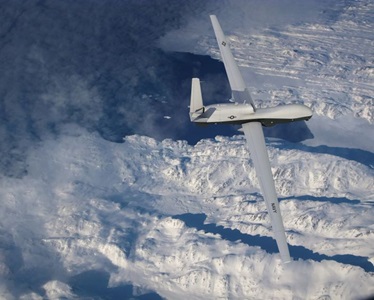The test flight proved the system's ability to operate in the harsh environment over the Arctic Ocean.
Eyes on the High North
Connecting the Arctic with Cutting-Edge Satellite Communications
By Caroline Mroz
The remote, isolated Arctic gives the phrase “going dark” a whole new meaning.
Not only are parts of the region engulfed in darkness for months at a time, its perch at the top of the globe makes the Arctic — often referred to as the High North — one of the most difficult locations on Earth to deliver communications.
U.S. and allied military forces in the Northern polar region can’t afford to be disconnected. The Arctic is more strategically important than ever before, and assured communications are crucial, explained Troy Brashear, vice president, satellite missions, Northrop Grumman.
“It used to be a very barren, ice-locked area of the world, sparsely inhabited and sparsely operated in,” said Troy, a U.S. Air Force veteran who has served in the Arctic region. “As glaciers melt and sea lanes open, opportunities have been created for the U.S. and our allies to operate in the High North, but it has also allowed our enemies to do the same. The need for communications has skyrocketed.”
Northrop Grumman is supporting this need with cutting-edge technology. Launched on Aug. 11, 2024, the Arctic Satellite Broadband Mission (ASBM) — a combined effort between Space Norway, the U.S. Space Force, Northrop Grumman, Viasat and the Norwegian Armed Forces— will establish full broadband coverage above 65°N, marking a new era of connectivity for the region.
Connecting the Far Ends of the Earth
By providing reliable and secure communication, the two-satellite ASBM constellation — hosted on Northrop Grumman’s GEOStar-3 satellite bus — will deliver broad benefits to the Arctic, according to Jeremy Novosad, program director, ASBM, Northrop Grumman. Two of ASBM’s Northrop Grumman-built payloads for the Norwegian Armed Forces and Viasat expand connectivity for everything from air travel to shipping and fishing to Allied operations, including search and rescue missions.
“Connectivity is the backbone of this unique mission,” said Jeremy. “It’s a very critical capability that we are delivering.”
Alongside Space Norway’s commercial payloads is the U.S. Space Force’s Enhanced Polar Systems-Recapitalization (EPS-R) payload. Also built by Northrop Grumman, EPS-R will deliver protected, anti-jam military satellite communications coverage to U.S. forces operating in the Northern polar region and will be enabled by the Control and Planning Segment (CAPS), Northrop Grumman’s next-generation ground system.
“The U.S. military has to have a presence in the Arctic region. While they’re up there, they have to make sure there’s good communications back to the domestic command-and-control authority,” said Steve Dunlop, program manager, EPS-R CAPS Ground System, Northrop Grumman. “EPS-R delivers faster, secure communications for U.S. forces, giving more capabilities for the warfighter. That’s the advantage.”
The inclusion of EPS-R in ASBM represents a historic moment for hybrid space missions: the first time an operational U.S. military payload is hosted on an internationally operated, commercial satellite.
The EPS-R payload was isolated from the rest of the satellite, enabling the payload to catch a ride on ASBM while meeting security requirements, said Rohit Raja, who served as program director, EPS-R, Northrop Grumman. The result is a trailblazing achievement that paves the way for future hybrid military-commercial launches.
An Eye to the Future
In coming years, the broadband connectivity delivered by ASBM will provide additional capabilities to commercial and military crafts to navigate the High North — similar to how a cell tower provides connectivity to nearby devices, said Inger Melby, capture director, Northrop Grumman. Inger grew up in Norway and now works on Northrop Grumman’s multi-intelligence MQ-4C Triton.
“Triton was designed to use wide-band satellites and is immediately capable of utilizing Norway’s investment in ASBM,” said Inger. “ASBM will provide the satellite coverage that could further support a Triton operating in the High North.”
The most advanced maritime intelligence, surveillance, reconnaissance and targeting capability deployed today, Triton does not currently operate in the Arctic but is under consideration for exactly that mission. The adoption of Triton in the region would bring unprecedented Northern polar maritime surveillance, according to Inger, delivering 24-hour coverage for the communications and command and control needed to keep a constant eye on the Arctic maritime domain.
Bringing the region online with ASBM is the first step in writing the Arctic’s next chapter. Underpinned by assured connectivity, the possibilities in the region are bright.
Learn more about the Arctic Satellite Broadband Mission


